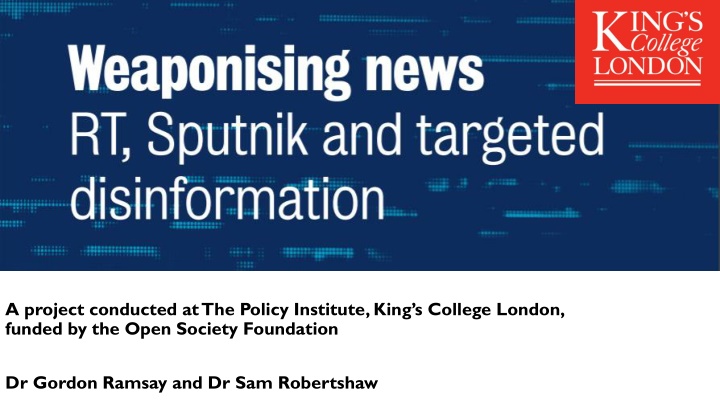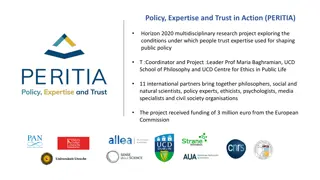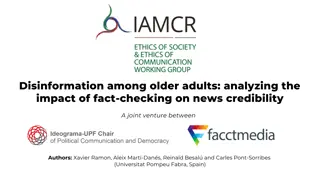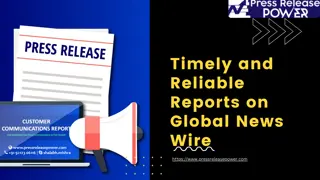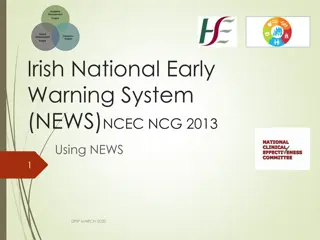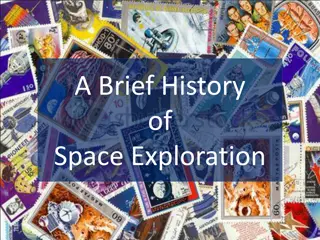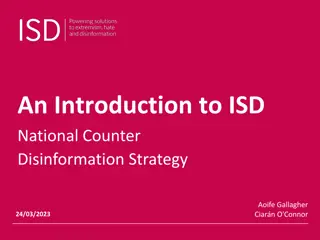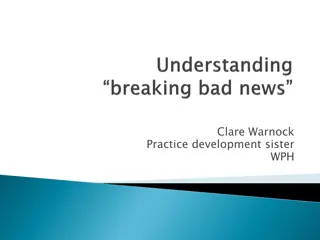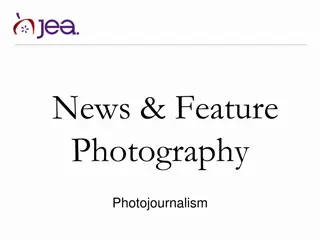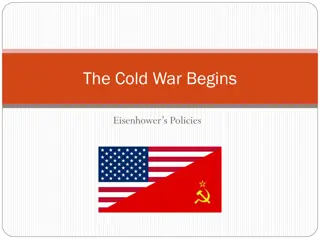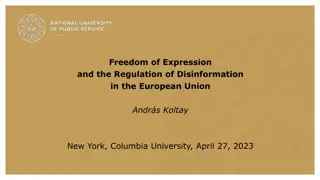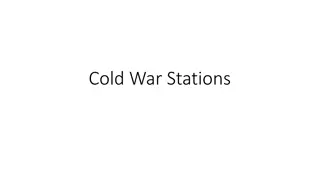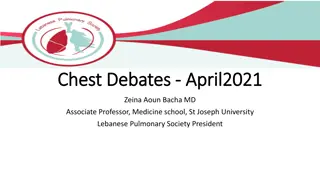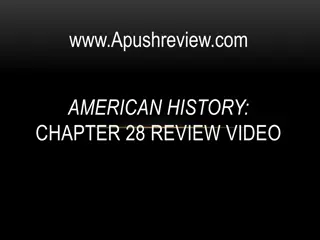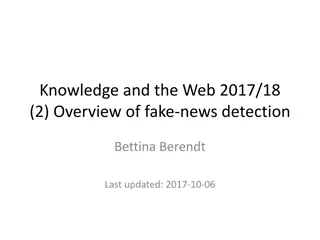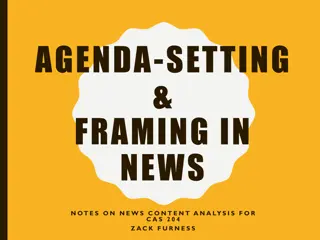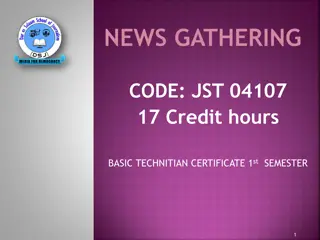Analysis of Weaponising News: RT, Sputnik, and Targeted Disinformation
A project conducted at The Policy Institute, King's College London, funded by the Open Society Foundation, delved into the extensive English-language output of RT and Sputnik. By examining the impact on news coverage in the UK, the project found consistent framing of European democracies as dysfunctional. It investigated motives, resources, and means of these outlets in presenting news globally, focusing on the aftermath of the Salisbury poisoning and Russian military strength. The study explored direct content replication and featured a unique news content collection and analysis tool known as Steno.
Download Presentation

Please find below an Image/Link to download the presentation.
The content on the website is provided AS IS for your information and personal use only. It may not be sold, licensed, or shared on other websites without obtaining consent from the author.If you encounter any issues during the download, it is possible that the publisher has removed the file from their server.
You are allowed to download the files provided on this website for personal or commercial use, subject to the condition that they are used lawfully. All files are the property of their respective owners.
The content on the website is provided AS IS for your information and personal use only. It may not be sold, licensed, or shared on other websites without obtaining consent from the author.
E N D
Presentation Transcript
Weaponising News: RT, Sputnik and Targeted Disinformation A project conducted at The Policy Institute, King s College London, funded by the Open Society Foundation Dr Gordon Ramsay and Dr Sam Robertshaw
Overview and Findings RT and Sputnik English-language output Damage limitation in the aftermath of the Salisbury poisoning Intensive focus on Russian military strength, with measurable effects on news coverage in the UK Consistent framing of European democracies as dysfunctional, repackaged and pushed at English-speaking audiences.
Project origins & aims NYT article (June 2017): Journalism as source and vector of disinformation Churnalism : Leveraging vulnerabilities in Western news org Salisbury incident: Journalism as a crisis management tool Motive, Resources and Means Research Questions 1. What can be learned from large-scale analysis of how Russian outlets present news, in English, to the world? 2. Is there evidence of direct content replication?
Introducing Steno Stenoproject.org Three-part news content collection and analysis tool: Collection and retrieval Scrapeomat Retrieval and analysis Steno GUI Matching and comparison Steno-Similar
Sampling and analysis 2 Russian sites: rt.com, sputniknews.com 17 UK sites: National broadcasters and press; 2 large digital-only outlets 8 week-long datasets 151,809 UK news articles; 11,819 from RT/Sputnik - May-June 2017; March 2018 Skripal coverage (Content analysis and text fragment-matching) NATO and Russian military (Frame analysis and dataset-matching) Dysfunction and agenda-building (Frame analysis and dataset-matching)
1. Skripal Coverage Flooding the zone 735 articles published by RT and Sputnik in the four weeks after the incident Narrative Groups: Novichok (20 narratives) UK/West response (32) Geopolitics/Conflict (26) Skripals behaviour (16) Western domestic politics (15) Russia s response (11) Conspiracies (7) Alternative narratives (11) 138 separate and often contradictory narratives; clustered in response to external events 215 separate sources a parallel commentariat
1. Skripal Coverage (Selected) Novichok Narratives 1. The Novichok used was from Porton Down 2. The Novichok used was not made in Russia 3. The Novichok used may be Russian, but was not made by the state 4. The Novichok could be from any other post-Soviet state 5. The Novichok could be from a Western country (e.g. Sweden) 6. The Novichok could be from Iran 7. The Novichok used was definitely developed in the USA 8. Novichok was initially created by the UK and US, not Russia 9. The nerve agent used was definitely not Novichok 10. The Novichok programme never existed
2. Military Coverage - Framing NATO 617 articles in total 80% contained one or more negative frames Paradox: NATO Aggressive yet weak; dangerous yet incompetent
2. Military Churnalism RT and Sputnik coverage of Russian military contains detailed information on weapon capabilities Elite source quotes from Russian government, military and arms industry figures Images and A/V content frequently embedded
2. Military Churnalism 10 UK articles replicated significant portions of RT or Sputnik articles on Russian military matters Replication detected using Steno- similar with a match factor of 10% 6 acknowledged the source; 4 did not Express, 10th March 2018 One article, six days after the Salisbury poisoning, based almost entirely on RT article on Russian weapons Daily Mail, 12th May 2018
3. Frames and Agendas: Western Dysfunction Frame analysis: Political Dysfunction 11 frames, grouped as: Conflict (political, institutional and social) Failure (political, military and public/private institutions) Alienation (Corruption, violence, inequality, anti-democratic practices) 82% of 2,641 articles about domestic issues in the UK, US, France, Germany, Italy, Sweden and Ukraine contained one or more Dysfunction frames Country-specific themes: Immigration and conflict in W. Europe; Violence and government failure in UK and US; Political failure and anti-democracy in Ukraine
3. Western Dysfunction: Agenda-Building RT and Sputnik more likely to cover immigration, Islam, terrorism and racial tensions than UK media Russian sources more often conflated immigration with Islam and violence/terrorism than UK media Content harvesting by Russian outlets for English-language publication: 44% of articles about immigration in Germany from local sources 74% of articles about immigration in Sweden
3. Detecting Content Replication Push : Russian >> UK Media Pull : UK >> Russian Media 21 articles with 30% match (factoring in quotes) Only 2 cite source All tabloids (Express: 13 articles) 11 articles about political issues and international events (including military) 32 articles with 30% match 17 cite source 20 from broadcasters or quality press 22 about political issues; dysfunction frames common
Project Outcomes Expanded empirical understanding Consistency of framing in key areas Selection and repackaging of content for target audiences Success in exploiting foreign media Damage control in international crises New tools for research and collaboration Foreign language test
News as Disinformation What is news? Definitional problems Schudson (2008) Journalism should support the conditions in which representative democracy (and journalism) can thrive Cross-border news provision New, easy to do, cheap (as an extension of foreign policy) Journalism, vulnerabilities and exploitation Problems of intervention and definition Regulation and power differentials Onora O Neill (2012) Communication rather than expression of content
Next Steps Continued Exposure:All journalism is bound by its record; infallible journalism even more so Joined-up Research: Parallel analyses; cross-country collaboration; bridging to social media Filling the gaps: Russian domestic news feedback News agencies Alternative news sites Beyond nation-states (motive + resources + means)
